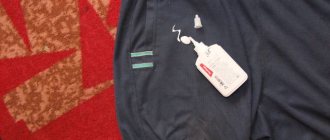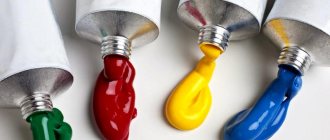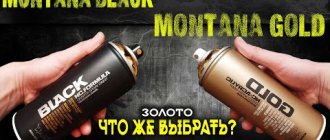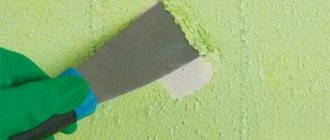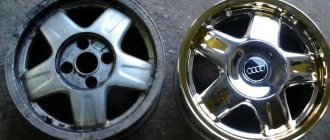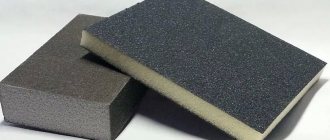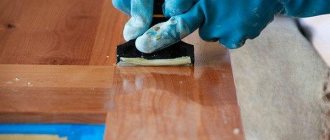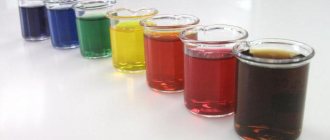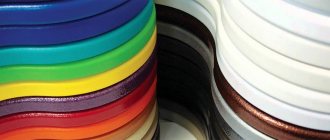Sometimes it happens that during painting, enamel stains remain on the parquet and linoleum. Therefore, many are interested in how to remove paint from linoleum so as not to damage its structure. This material is susceptible to damage, so when removing paint marks, it is better to use the tips we provide below. In this article we will look at all the ways to remove both new and old stains from linoleum.
Oil paint
At least once in our lives, each of us faces such a problem as a paint stain on our favorite blouse or skirt. But there is no need to fall into despair and rush to throw away your favorite thing or send it to rags. After all, knowing little secrets, you can easily wash away the dirt.
When deleting, you must adhere to the following rules:
- It is much easier to remove a fresh, not dried stain. Therefore, the sooner you begin to wash away the dirt, the more positive the effect will be. Read: How and with what to remove tar stains.
- You need to remove dirt after you make sure that the fabric will not deteriorate from exposure to the selected product. Test cleaning should be carried out on the least visible area of the product. Allow the substance to sit for at least 10-15 minutes, and only after you are sure that everything is in order, you can start cleaning.
- Another equally important condition is that you need to clean it only from the wrong side, after removing the dirt with unnecessary rags.
- It is much easier to remove dye from thick fabric. Also, the thinner it is, the more carefully you must do everything so as not to damage it.
Now let's look at how to remove stains using various means:
- If the mark has just been placed, be sure to blot it. Then try cleaning with soap that has the effect of removing dirt and stains. Lightly moisten the problem area with warm water, rub with soap, and lather well. Rinse off, if you do not get the expected result the first time, you can repeat the procedure. Find out: How to wash fuel oil from clothes?
- The most effective way to remove traces is to use a solvent, for example, gasoline, kerosene, white spirit, acetone (it must be diluted beforehand). Such compositions are capable of scrubbing off paint, even if it has already dried. Lay the product out on a flat surface and place a pad under the mark. Soak a small piece of cotton wool in the solvent and start cleaning. You need to scrub very carefully, moving from the edge to the center. Small elements of contamination can be cleaned with ammonia. This method should absolutely not be used for delicate or synthetic products. The final stage of cleaning is washing with concentrated detergent.
- Using fats, of course, this method is not suitable for old stains, but it can be used for delicate fabrics. Butter, vegetable oil, and olive oil are used as a cleaner. Use an orange stick or similar object to remove the top layer of stain. Then apply a sufficient amount of fat to the problem area and set aside for several hours. After the allotted time has passed, remove the grease using dishwashing detergent or ammonia. The final stage is cleaning in an automatic machine on intensive mode.
Making your own washes
At home, you can prepare your own solutions that can be used to remove old paints. It is necessary to determine which dye was used, and then apply the desired solution.
Solution #1
To remove oil paints, which also include alkyd paints (previously, thickly grated paints mixed with drying oil were used), a solution made up of two volume parts of ammonia (Fig. 10) and one part of turpentine (Fig. 11) is used. It is mixed and then applied with a brush to the object from which the old oil paint needs to be removed.
Container with Turpentine
After about an hour, the coating swells and the old layer is easily removed. The only drawback of this solution is its rather pungent odor. Therefore, work should be carried out outdoors.
Bottle with ammonia
Solution #2
It is easier to wash off metal using acids. Therefore, used sulfuric acid (used in batteries) can be used to remove old paint. It should be diluted in a ratio of 1 to 10 with water. Then apply the solution onto the paint with a brush. Wash off with plenty of water, wiping the surface with a brush.
Attention! Pouring acids into water. It's impossible to do the opposite! The solution will boil, causing splashes that can burn.
Solution #3
Nitroenamels are removed using solvent No. 646. Pure acetone can be used. It is simply applied to the surface. If the coating is quite thick, then moisten a rag and apply it to the place from which you want to remove the paint.
Watercolor and gouache
Watercolor or gouache can be washed off quite easily, the main thing is that the following rules are followed:
- You need to start cleaning immediately after you have made a blot.
- Immediately blot the stain with a napkin or scrap cloth.
Products that will help remove stains:
- If we are talking about finger watercolor paint, just moisten the stain in warm water. Lather with laundry soap, rub thoroughly, leave for 20-30 minutes and rinse. If after the first time the desired effect was not achieved, repeat it again.
- Ammonia plus glycerin
. It is necessary to combine these two components in equal proportions, after slightly heating the glycerin, and apply the prepared composition to the contamination. Leave for 60-70 minutes, and then rinse and wash.
- Composition for degreasing dishes
. Soak the problem area in warm water, then apply a couple of drops to the blot. Rub and rinse; to increase the effect, you can soak the product in this product for several hours.
- To remove the substance from white clothes, use special
paint stain removers Compositions from Sodasan, HG, Boss, Vanish cope well with this. You must act in accordance with the manufacturer's recommendations.
- Using solvents
, such as nail polish remover. Soak a cotton swab in solvent and start cleaning. It is necessary to process from the edge to the center of the stain, continue the procedure until the color pigment completely disappears.
How to remove from a car?
Spray paint on a car can be removed using car shampoo. It is suitable for cleaning stains that have recently been applied.
How to use it:
- Pour warm water into a bucket, add car shampoo, whisk until foam forms.
- Dampen a rag or sponge in the solution.
- Apply to the surface of the car.
- Leave for 5-10 minutes, rub gently.
- Rinse the body with clean water.
Car shampoos are sold in auto parts stores.
The most popular means:
- Fill INN FL045. 400 ml costs 200 rubles;
- AUTOPROFI. 1000 ml costs about 300 rubles;
- Expert "Active foam". 1 liter costs 170 rubles.
If you are unable to remove the stain with car shampoo, you can use professional anti-graffiti products. These may be compositions such as:
- Anti-Graffiti Neat. The cost of the spray is 400 rubles. It is applied to the body for 5-7 minutes with a roller. Then remove with a clean cloth and rinse with water.
- Grass. Universal spray for removing various types of stains. Cost 220 rubles for 0.6 liters.
- Graffiti Guard. The cost of the product is 110 rubles.
The longer the paint remains on the surface of the car, the more difficult it is to remove. The situation is aggravated by exposure to sunlight on the body.
Another option is to go to a car wash and entrust your car to professionals. The cost depends on the scope of work. Washers have specialized removers at their disposal that will safely rid vehicles of the most difficult stains.
Other ways to help remove marks from your car:
- Carnauba wax, such as Butter Wet Carnauba Wax. They can be used to carefully clean your car from aerosol paint. There will be no scratches or dents left on the surface. Apply the product to a sponge and rub the stain. The movements should be circular. After removing the paint, the surface of the car is polished with a clean soft cloth. The liquid costs about 200 rubles for 330 ml.
- Nail polish remover. It can be used to remove small stains.
- Acetone.
- Gasoline or kerosene.
- Cleaning clay, such as Willison or Sonax. The method of its use was described above. The average cost of such a product is 1000 rubles per 100 g.
A porous microfiber cloth has good cleaning ability. It will make it easier to remove paint.
The video will show you how to remove spray paint from the surface of a car:
Water-based paint
It is not difficult to remove the water-based trace, especially if it has not yet dried, just rinse it under running warm water. And then soap it with soap or put it in the washing machine. But if the solution has already dried, you must first clean the top dried layer. To do this, use a construction spatula or a similar object; you need to scrape very carefully so as not to damage the texture of the fabric. Once most has been cleaned, the residue can be removed using the following means:
- Solvent
. Moisten the problem area with this product, set it aside for a couple of hours, and then wash it as usual. - Petrol.
Dampen an unnecessary rag with gasoline and start scrubbing the blot. After the problem disappears, you need to wash the clothes at the maximum permissible temperature.
Latex paint
Now let’s figure out how to wash latex paint from clothes.
- The first thing to do is spray hairspray
. If you don’t have varnish at home, you can use any product that contains alcohol, or pure alcohol. Then start rubbing vigorously with a sponge or rag, periodically moistening it with alcohol. The final stage is washing and drying.
- You can also use alcohol with salt
. The salt will act as a kind of scrub; wet the dirt with alcohol and sprinkle salt on top. Rub thoroughly and rinse in warm water.
Reliable stain remover
Paint stores sell paint remover. This is a specially formulated chemical. There is both a universal product and one made only for acrylic. It has a strong unpleasant odor.
Removing stains with this preparation must be done with the window open. Hands, respiratory organs and eyes must be protected with special means - gloves, a respirator and goggles.
To remove stains you need:
- moisten the fabric in the product;
- wipe the surface to be treated;
- wait 10 minutes and wipe off any drops or streaks with a clean rag;
- After completing the procedure, the treated surface must be washed with warm water and soap.
This universal substance helps remove drops and streaks from any surface. For it, there is no concept of timing for the appearance of stains, since it removes traces of acrylic after a long time. However, due to the aggressive composition of the drug, it should be used as a last resort when other means have not helped.
It is commonly believed that waterborne paints are highly flammable, and this is true. They are especially dangerous in the first minutes after application. However, sometimes serious complications can arise, since each paint has certain additives that give it certain qualities. Acrylic paints are actively used in everyday life, and there are often times when it needs to be washed or removed from some surface.
Acrylic paints contain water, a pigment that gives color, acrylic acid, a film-forming substance, due to which the layer hardens in just an hour. For this reason, the sooner the process of removing paint from surfaces begins, the easier it can be done. Today we will learn how to quickly and easily remove acrylic paint from various surfaces.
Acrylic can be removed from the surface in several ways. In this case, you will need to use certain substances and tools.
Acrylic paint
Acrylic paint contains polymers, with the help of which it becomes resistant. And once it dries, it will be very difficult to remove. Therefore, the sooner you start cleansing, the better the outcome will be.
The cleaning method is as follows:
- While it has a liquid consistency, blot it with a napkin or paper towel.
- Turn the product inside out.
- Rinse the problem area in slightly warm water.
- Then lather the product with laundry soap
and rub.
- Set aside for 3 hours.
- Wash it.
- To clean more severe stains, you can use the following composition: dissolve 2 tablespoons of washing powder or gel in a glass of warm water, add 50 milliliters of vinegar. Then use a sponge to clean the clothes until they return to their original appearance.
- alcohol-containing products
are also excellent for cleaning . The fact is that it is he who is capable of qualitatively dissolving such a dye. You need to treat the problem area with alcohol, then put the clothes in a bag and leave for a couple of hours. After sending it to the SMA, select the intensive mode, with the maximum permissible temperature for the tissue of this composition.
- Turpentine
can also work well with this type of paint. Pour turpentine into a small container and soak the damaged area of clothing there. Leave for half an hour, then scrub with a soft brush or sponge. The final stage involves the use of laundry soap.
Methods for removing water emulsion from walls
Various methods are used for this event, each has its own advantages and disadvantages, but any work begins with preparing the room. It is necessary to remove everything unnecessary from the room; stationary objects, the floor and window openings are covered with cellophane. The door is hung, and the canvas is well wrapped with suitable material.
After this, you can begin the process.
The easiest way is to wash with water. Suitable for surfaces treated with compounds that cannot withstand prolonged exposure to liquids. To determine this, wipe a small area with a damp cloth. If the dye remains on it, and there are traces on the surface, then it will be easy to wash off the layer.
Water allows you to clean small surfaces in a short period of time. The procedure is as follows:
- Prepare the container and liquid. The water should be warm, this makes the process easier.
- During operation, the water will need to be changed several times, as it quickly becomes dirty. If this is not done, the coloring composition will simply be transferred back and the desired result will not be achieved.
- A spray bottle is used for application; it makes it possible to treat a large area at once. The convenience of such a device is also that you can control the uniformity of processing.
- Water is applied gradually. Wet areas become dark.
- After this, moisten the sponge and wipe the surface well. The movements should be accompanied by slight pressure. Each location is processed several times. In this case, the sponge is periodically wrung out.
- If the coating is difficult to remove, then a spatula comes to the rescue - they clean off difficult areas. It will also come in handy for corners.
This method avoids a lot of dust. But due to the fact that the work is accompanied by drips, which cannot always be controlled, the baseboard area needs special protection to prevent damage to the floor.
Soap solution
When deciding how to clean water-based paint, another simple option is taken into account; it is similar to the previous one, but a soap solution is used. This composition allows you to work on coatings that have been treated with several layers of water-based emulsion.
- Soap or washing powder (preferably without fragrances) is diluted in warm water until a rich foam is obtained.
On a note! Working with soap is much easier if you grate it or scrape it with a knife.
This method also requires constant changes of water and requires more thorough rinsing so that no soap film remains.
Mechanical method
To remove water-resistant paint, a mechanical method is used. It includes two options that differ in the method of influence:
Removing the composition using a spatula and hair dryer. This technology is more suitable for oil-based and alkyd paints, but can be used for water-based compositions that contain vinyl and acrylic. The base is heated with a hairdryer, the area is immediately treated with a spatula, the heating does not stop. For convenience, the cleaning tool should be in the main hand, and the hair dryer in the other. This allows for continuity. But this option does not always give the desired result, because the water base complicates the process.
Removing paint using a drill with a special attachment is a quick and trouble-free method, although very dusty
On a note! Sometimes the question arises of how to wipe off the water-based composition from places where it was accidentally deposited. If the solution is fresh, wash it off with plain water; if it dries, use a suitable tool. For example, the impact on plastic should be minimal, so use the hard side of a dish sponge or a wooden spatula to clean it.
Paint remover
Water-based paint remover is used in cases where there is not enough time or the work is carried out outdoors. The fact is that this product is a special chemical solution, which, due to reagents, affects the composition of the coating. This allows you to get excellent results
But washing is harmful to health, so work is carried out in well-ventilated areas with the necessary precautions
The mixture in the required quantity is applied to the base and left for the specified time. The swollen paint is removed with a spatula, after which the entire surface is washed with warm water.
This option is great for cleaning wood or drywall that is easily damaged by other methods. The main thing when choosing is to read the manufacturer’s recommendations, because some compositions are not suitable for certain wall materials.
In special cases, special processing is necessary to minimize chemical exposure.
Nitropaint
Nitro paint is a persistent compound that requires aggressive compounds to remove.
The cleaning process looks like this:
- Freshly deposited contamination can be removed using acetone
. Lay the item on a flat surface and soak the stain. Then pour solvent on it, wait a couple of minutes. Then rinse under running warm water and squeeze out. Lay out again and fill with dishwashing detergent and wash.
- Using a special solvent
, it can be purchased at any hardware store. Please note that this product is quite aggressive, so it is not suitable for delicate fabrics. Apply a small amount of solvent to the dirt and scrub thoroughly with a sponge. Rinse, wash.
Modern methods of damage removal
Along with folk methods, there is a whole class of professional car care products that can be easily purchased in specialized stores.
How to remove silicone sealant from plastic windows? Some of them are useful to adopt now. 1. A fairly common remedy is scratch remover paste. However, few people know that it is effective not only in combating mechanical damage, but also can erase traces of paint. Apply the product to a dry cloth and wipe the areas stained with paint until the stains disappear completely.
It would be optimal to purchase a special microporous sponge along with the paste.
3. Automotive experts say that a brake pad cleaner spray can also cope with dirt. You need to apply the product to a rag, treat the stain with small fragments and wipe with a dry cloth.
This product is well suited for the type of stain where the paint mark is easily pressed through with a fingernail.
Hair dye
Every woman faces this problem from time to time. But don’t rush to despair, the problem can be solved, and quite quickly.
First of all, immediately rinse the mark under running warm water and soap it with laundry soap or stain remover soap.
If the result is not achieved, try the following:
- Hairspray
or
alcohol-containing products
. Dampen the sponge with alcohol or varnish and start scrubbing. When all the coloring pigment has completely disappeared, wash the product. - Hydrogen peroxide
. Pour peroxide into a small container and place the damaged area of clothing there for half an hour. After the time is up, machine wash it.
General recommendations
Gouache and watercolor are not a problem, but what to do with a dried stain of drying oil, water-based emulsion and other complex compositions? Do not try to wash off alkyd paint with water and powder. Always keep solvents like lighter fluid or white spirit in your household. Laundry soap and a number of unexpected folk recipes will help: lemon juice, hairspray and even dish gel.
First steps when a stain appears:
- Blot it with a dry cloth or paper. Let the paint soak in as much as possible.
- Examine the item's label.
- Determine the type of paint.
- Don't put off cleaning until later. If you don’t have time at all, then try to at least soak the stain in a suitable solution.
- If a harsh solvent is required, test it on an inconspicuous area of clothing or on a fabric sample that came with the item. If the fabric is not faded or warped, solvent can be used on the stain.
- Remember to ventilate the area and wear protective gloves when working with aggressive solvents.
